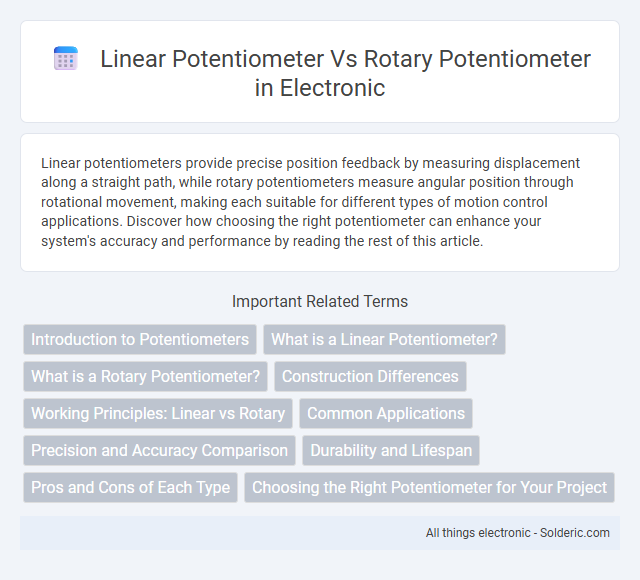Linear potentiometers provide precise position feedback by measuring displacement along a straight path, while rotary potentiometers measure angular position through rotational movement, making each suitable for different types of motion control applications. Discover how choosing the right potentiometer can enhance your system's accuracy and performance by reading the rest of this article.
Comparison Table
| Feature | Linear Potentiometer | Rotary Potentiometer |
|---|---|---|
| Motion Type | Linear displacement | Rotational displacement |
| Measurement | Position along a straight line | Angular position |
| Typical Application | Linear position sensing, industrial automation | Volume control, angle measurement |
| Output Signal | Variable resistance proportional to linear movement | Variable resistance proportional to angular movement |
| Range of Motion | Limited by stroke length (usually few centimeters) | Typically 270deg to 360deg rotation |
| Size & Form Factor | Elongated, linear design | Compact, cylindrical design |
| Accuracy | High linear accuracy | High angular accuracy |
| Installation | Requires linear movement mechanism | Simple rotary knob or shaft |
Introduction to Potentiometers
Potentiometers are variable resistors used to measure and control electrical voltage by adjusting resistance along a conductive path. Linear potentiometers change resistance proportionally along a straight track, ideal for precise linear position sensing in applications like joysticks and sliders. Rotary potentiometers vary resistance through angular displacement, commonly used in volume controls and tuning devices for smooth rotational adjustment.
What is a Linear Potentiometer?
A linear potentiometer is a sensor that measures displacement by converting linear motion into a variable electrical signal, providing precise position feedback. Its resistance changes proportionally along a straight path, making it ideal for applications requiring accurate linear position detection. You can typically find linear potentiometers in industrial machines, robotics, and automotive systems for monitoring linear movement.
What is a Rotary Potentiometer?
A rotary potentiometer is an electrical component that measures angular position or adjusts voltage by rotating a knob or shaft. Unlike a linear potentiometer, which slides along a straight path, the rotary type provides continuous rotational input over a fixed arc, making it ideal for volume controls or tuning applications. Your choice between the two depends on the application's movement type and precision requirements.
Construction Differences
Linear potentiometers feature a slider moving along a straight resistive track, providing a direct linear output, while rotary potentiometers use a rotating shaft that turns a circular resistive element. The construction of a linear potentiometer allows precise measurement of displacement in a straight path, whereas rotary potentiometers measure angular position. Your choice depends on whether linear or rotational input measurement suits your application.
Working Principles: Linear vs Rotary
Linear potentiometers operate by sliding a wiper along a straight resistive track to measure displacement, converting physical movement into a proportional electrical signal. Rotary potentiometers function by rotating a shaft connected to a resistive track in a circular path, changing resistance according to angular position. Your choice between linear and rotary potentiometers depends on whether you need to measure linear displacement or rotational angle accurately.
Common Applications
Linear potentiometers are commonly used in position sensing for industrial machinery, robotic arms, and automotive throttle controls due to their precise measurement of linear displacement. Rotary potentiometers frequently serve in audio equipment volume controls, tuning dials, and steering angle sensors, offering intuitive rotational input detection. Both types are integral in feedback systems for accurate control and adjustment across various electronic and mechanical devices.
Precision and Accuracy Comparison
Linear potentiometers offer higher precision and accuracy due to their direct measurement of linear displacement, minimizing errors caused by angular misalignment. Rotary potentiometers can experience nonlinearities and inaccuracies from shaft wobble and variable contact resistance throughout rotation. For applications demanding fine resolution and consistent output, linear potentiometers provide more reliable and stable readings compared to rotary types.
Durability and Lifespan
Linear potentiometers typically offer higher durability and longer lifespan in environments with frequent or heavy mechanical stress due to their straightforward sliding mechanism and robust housing. Rotary potentiometers, while generally reliable, may experience faster wear and reduced lifespan because of the constant rotational friction on the wiper and shaft components. Materials such as conductive plastic or metal film, and sealed designs, significantly enhance both types' resistance to dust and debris, directly impacting long-term performance and durability.
Pros and Cons of Each Type
Linear potentiometers offer precise position measurement with straightforward output voltage proportional to displacement, making them ideal for applications requiring accurate length or distance sensing; however, they tend to be bulkier and less durable under harsh conditions compared to rotary types. Rotary potentiometers excel in compact designs and durability, providing smooth rotational input for user controls or angle measurements but may have limited resolution and susceptibility to mechanical wear over time. Choosing the right potentiometer depends on your specific needs such as space constraints, environmental exposure, and required measurement accuracy.
Choosing the Right Potentiometer for Your Project
Selecting the right potentiometer depends on your project's specific requirements for motion and space constraints. Linear potentiometers provide precise, straight-line position sensing ideal for applications needing accurate distance measurement, while rotary potentiometers suit rotational control tasks such as volume adjustment or angle detection. Understanding your needed range of motion and installation environment ensures you choose the optimal device to enhance performance and reliability.
Linear potentiometer vs rotary potentiometer Infographic

 solderic.com
solderic.com